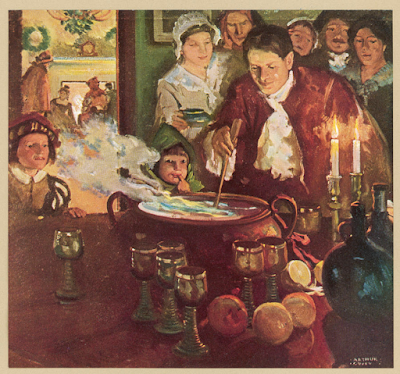Today is Twelfth Night, that most curious of all winter holidays, consigned to the mists of time. In my last post, I mentioned that Christmas in colonial times was a quiet, understated event and that the Christmas celebrations as we know them became popular in the early to mid-19th century. So...were our founding fathers and mothers a bunch of stiffs?
On the contrary, the holiday they celebrated most raucously (especially in Virginia, Maryland, and around Philadelphia) was Twelfth Night, the night of the twelfth day of Christmas and the day before the Epiphany. During the American Revolution, it was the major winter celebration.
Twelfth Night is the trifecta of holidays, sitting at the convergence of Christmas, the Epiphany, and the Winter Solstice. Though originally rooted in pagan fertility rites, the annual practice of an extended Winter Solstice festival of feasting, family gatherings, and public gaiety was later grafted into the emerging Christian culture of Europe. Burning the Yule Log during the twelve days was part of this and continued into colonial times. Clearly a throwback to the pagan holidays of the Roman Saturnalia and Celtic traditions, I believe Twelfth Night manifests the human condition - one that necessarily embraces the new (Christianity) while holding onto nostalgic vestiges of the old (pagan and Celtic).
Twelfth Night was widely celebrated in colonial Williamsburg, Philadelphia, and the Delaware Valley. George and Martha Washington celebrated it as a day-long event with many friends and family in attendance. Events included the famed costume ball, where the high-born dressed as low-born and the low-born dressed as high-born, and where men could dress as women and women as men. In Philadelphia, the upper classes (mostly staid Quakers) simply dressed in finery and listened to chamber music while feasting, but in many places, the more raucous aspects of the old pagan traditions included all kinds of drinking and carrying on. Sometimes special cakes or loaves of bread were baked with a hidden bean or a metal cast figure of the infant Jesus. Whoever was served the piece of cake or bread with the hidden token became the King or Queen of the Twelfth Night Ball.
Twelfth Night involved baking all sorts of tasty winter treats, such as cakes, pies, and tarts. The presentation of the food was a key form of entertainment. In the days before, most foods could not be preserved, so baking was no mean feat. Did I mention that raucous drinking (at least among non-Quakers) was a big part of Twelfth Night? In earlier times in England and Ireland, the drink of Twelfth Night was Wassail - a mix of mead, ale, and spices that would give even Captain Morgan a headache. In some traditions, the Wassail was spread over the cold winter fields to signify a fertile harvest in the spring. It was also poured onto trees, another connection to pagan traditions.
Enjoying the Wassail Bowl
In colonial and early American times, the Christmas season, capped by the celebration of Twelfth Night, was associated with romance and was a favorite time for weddings. Twelfth Night balls offered young, single people the chance to meet and interact freely, and, hopefully, to find a mate. These parties, usually featuring dancing, some form of masking, and card and dice games, facilitated this goal. Indeed, some balls were designed exclusively for the young. One famous colonial romance led to a marriage scheduled for Epiphany, the day after Twelfth Night. George Washington and his bride, Martha Dandridge Custis, married on January 6, 1759.
 |
| The wedding of George and Martha |




No comments:
Post a Comment